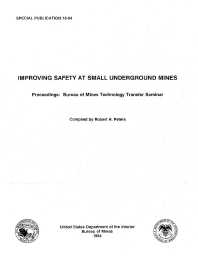Mining Publication: Pillar Design and Strategies for Retreat Mining
Original creation date: January 1994
One of the keys to miner safety and an efficient recovery of the reserves is to design sufficiently sized production pillars that will prevent pillar squeezes, excessive pillar spalling, severe floor heave, roof falls, and pillar bumps. Currently, few mine operators design sections that will be retreat mined using empirical formulas or numerical models that estimate abutment pressures generated by adjacent mined-out workings. The U.S. Bureau of Mines is in the process of field testing and refining a "user friendly" computer program called Analysis of Retreat Mining Pillar Stability (ARMPS) to estimate abutment pressures developed during pillaring. Analyses of 68 pillar design case histories using the ARMPS program indicate that it can be successfully employed to predict pillar line stability during retreat mining operations.
Authors: FE Chase, C Mark
NIOSH/USBM Numbered Publication - January 1994
NIOSHTIC2 Number: 10005494
In: Peters RH, ed. Improving Safety at Small Underground Mines. United States Department of the Interior, Bureau of Mines SP 18-94, 1994; :15-23
See Also
- Analysis of Pillar Design Practices and Techniques for U.S. Limestone Mines
- Assessment of Stable and Failed Pillars in Underground Limestone Mines
- Deep Cover Pillar Recovery in the US
- The Effects of Roof and Floor Interface Slip on Coal Pillar Behavior
- Pillar Design Issues for Underground Stone Mines
- Proceedings: New Technology for Ground Control in Retreat Mining
- Reducing the Risk of Ground Falls During Pillar Recovery
- Sizing of Final Stumps for Safer Pillar Extraction
- The State-of-the-Art in Coal Pillar Design
- The Unpredictable Life Cycle of a Coal Pillar
- Content source: National Institute for Occupational Safety and Health, Mining Program


 ShareCompartir
ShareCompartir
